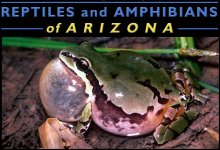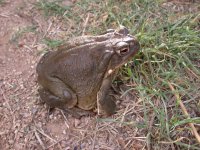| Range: |
 |
| Other Names: |
Colorado River Toad |
| Description: |
New Mexico's largest toad, Sonoran Desert toads grow to 7.5 inches or more in length. They resemble frogs in that they have relatively smooth, typically olive-green/brown skin, but they can be identified as toads by the crests on the head (cranial crests), and prominent, elongated glands on both sides of the back of the head (parotoid glands) and on the hind legs. Young toads have small dark, orange-tipped spots on the back. Larger tadpoles are gray or brown with a rounded tail tip, and grow to about 2.25 inches. |
| Habitat: |
This toad is found in semi-desert grasslands, oak, and occasionally pine-oak woodlands to about 5,800 feet. It is found the from valley bottoms well into lower-elevation hills and mountains. |
| Behavior: |
Most Sonoran Desert toads are found at night during the monsoon season, but they may emerge a month or more before the summer rains begin, particularly in areas of permanent water. |
| Hibernation: |
Outside of the summer activity period, Sonoran Desert toads remain in rodent burrows or other underground retreats. |
| Reproduction: |
Breeding usually occurs on one night within 2 or 3 days of a rainfall event of greater than one inch. However, at some permanent water localities, breeding may be independent of rainfall. They breed in permanent or temporary waters such as cattle tanks, reservoirs, backwaters, and ponds. Males either call for females from the shallow waters of the breeding pond or actively search for females. The call resembles a ferry boat whistle. Females deposit long stringers of up to 8,000 eggs in shallow water. Tadpoles typically metamorphose in a month or less. |
| Diet: |
Sonoran Desert toads eat just about anything that moves and will fit into their mouths, including insects, centipedes, spiders, lizards, mice, and other amphibians. |
Adapted from account on reptilesoaz.org
Sources:


|













